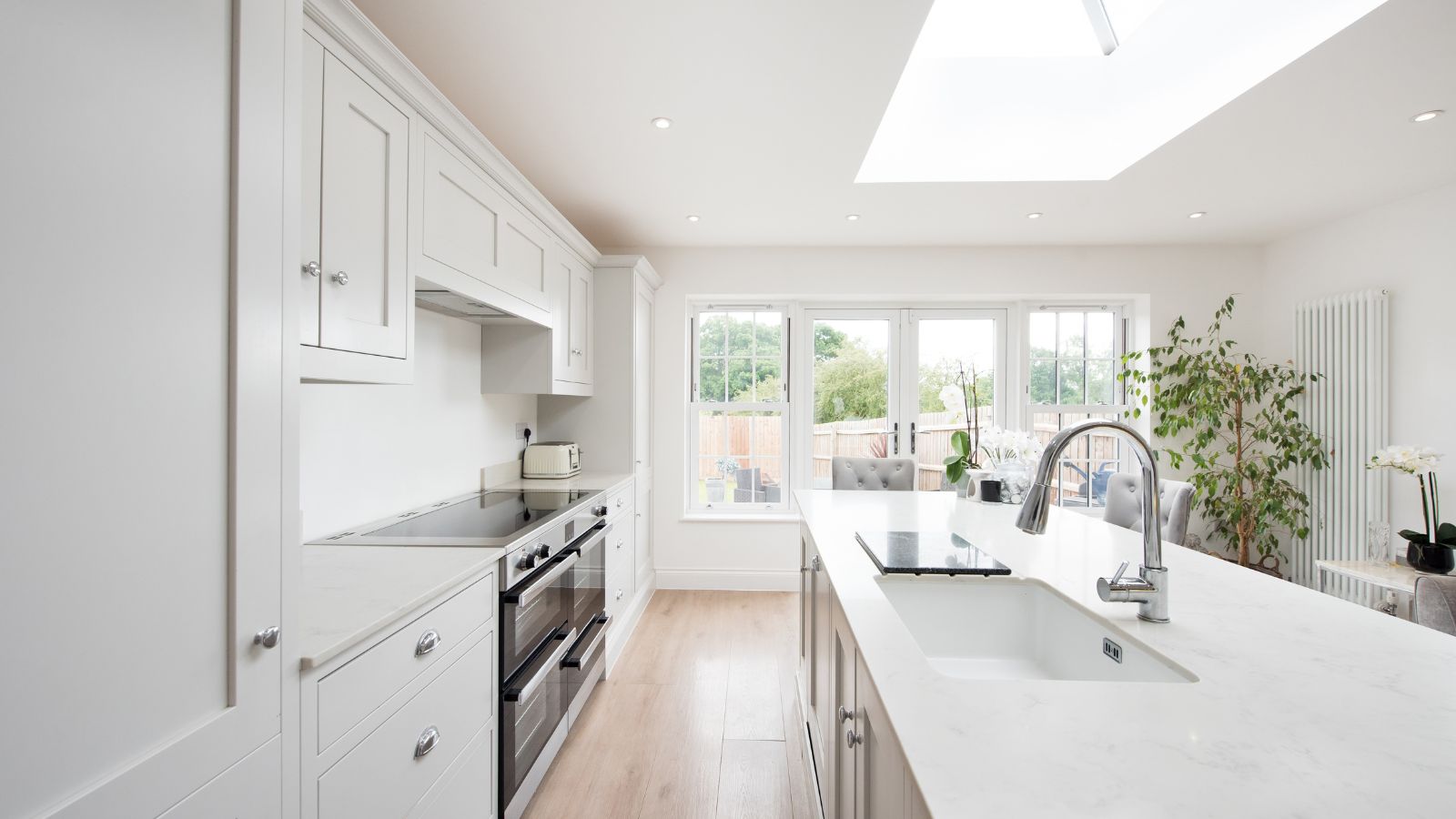How to paint Formica countertops yourself - 4 steps for a perfect finish
Painting experts reveal their essential tips for this transformative DIY kitchen project

Formica countertops – also known as laminate countertops – are always a great option for those looking to update their kitchen on a budget. If your old Formica countertops are looking a bit tired, or you fancy a new look, a fresh coat of paint is a straightforward solution.
Invest in the right tools and techniques and your countertops can take on a whole new lease of life. You’ll save yourself some serious dollars compared with a kitchen remodel and you can do it yourself.
Here you’ll learn what items you’ll need, how to apply it and the tools needed to transform your countertops in this chic DIY project.
Painting Formica countertops
What you'll need
Primer: Formica countertops are effectively laminate with a shiny surface and are not porous like wooden countertops. So, alongside the right preparation, you'll need to choose a suitable primer that will cover the Formica surface and adhere well to provide a strong and stable base for the top coat.
Benjamin Moore Insl-x Stix Primer is a top quality water-based choice for priming Formica. It is an acrylic urethane bonding primer which offers excellent adhesion and dries to give a very hard surface and is compatible with most top coat paints.
Painting pro Brandon Walker from ASAP Restoration suggests that you use a XIM Primer (such as this XIM UMA Acrylic Bonder and Primer/Sealer from Amazon) 'to get the best paint adhesion.' Manufacturer Rust-oleum recommends the primer for Formica and it can be used with Oil/Alkyd, Latex, Urethane, Epoxy and Lacquer top coats.
Paint: For the paint, select a specialty acrylic or enamel paint that can adhere to laminate and withstand regular kitchen wear and tear.
'After you’ve used a high-quality primer, the next layer of paint formulation matters a bit less since it will really be adhering to the primer layer,' explains Walker. 'But it’s always good practice to get paints that fit the medium they will be used on.'
So what paint does Walker recommend? 'For this surface the best option is to use an enamel or an epoxy surface coating to get the best results with a high-quality and durable finish.' The BEHR PREMIUM Urethane Alkyd Semi-Gloss Enamel from Home Depot is a great for a tough durable finish.
However one point to know is that enamel-based paint also needs to fully cure before you can use it, which can take one to two weeks. Latex-based paint can also be an option if you prefer that finish, but it tends not to hold up to heavy use, so may not be suitable for kitchen countertops. There are specially formulated kitchen counter paints that dry quickly and don't need priming including the Beyond Paint colors available on Amazon.
If you are not confident with a paint sprayer then a brush and roller will do the job. But, really, Walker recommends that you spray. 'Always spray surfaces that need a high-quality surface when finished.'
He adds, 'Spraying is a more uniform coating and it is easier to blend than rolling or a paint brush. This will achieve better results in the long run, and for something like a kitchen countertop, you want it to be as high-quality as can be.'
We recommend the HomeRight Quick Finish HVLP from Home Depot as it's affordable, handheld and easy to use. Or, this Paint Roller Brush Set from Walmart will do the trick if you're not quite confident enough to use a sprayer.
Step 1: Clean countertops
‘Start by thoroughly cleaning and preparing the surface of your Formica countertop,’ suggests Karina Toner, Operations Manager at Spekless Cleaning. ‘This includes removing any dirt, grime, or grease that may have accumulated over time. A mild cleaner and sandpaper can help with this process.’
Clean the surface with a water-based cleanser – soap and water is usually good enough. It's best to use an abrasive cleaning pad (such as the 3M Scotch-Brite General Purpose Hand Pad from Amazon), while you are scrubbing away the dirt and grime.
Not only will this eliminate the debris caked on, but it will also abrade the surface gently primer and paint adhere more readily.
Step 2: Prep and prime surface
Fill any gaps, cracks or divots with a bonding compound to get a flat surface to work on when priming and painting. Make sure to sand down the compound to a completely flat sheen that blends with the existing surface level.
Once the surface is clean and dry, sand the surface lightly with a fine-grit sandpaper block from Amazon to scuff it up; this helps the primer adhere better. Apply either of the aforementioned bonding primers designed for glossy surfaces to seal the raw particle board, to provide a solid foundation for the topcoat.
It’s important that you invest time in prepping your Formica countertops for painting. If not done correctly, water may seep under the sink edge, causing swelling and rot, which can lead to the whole unit needing replacing.
Step 3: Painting
Apply the paint in multiple thin layers using a paint sprayer or a foam roller and brush. Don't forget to allow each layer to dry completely before adding the next one (it might need two to three layers).
While the process may take some time and patience, the end result will be well worth the effort.
Step 4: Seal
After the final paint coat is completely dry, Kriss Swint, Design Lead at Westlake Royal Building Products, recommends applying a clear acrylic sealer such as Rust-Oleum 284470 Varathane Triple Thick Polyurethane from Amazon.
‘This step is vital as it protects painted surfaces from moisture, stains, and scratches,’ says Kriss. ‘Alternatively using a water-based sealer adds durability without yellowing over time.’
This practice can extend the life of your countertops significantly, demonstrating up to 70% more durability compared to unsealed surfaces.
FAQs
Can you use chalk paint on Formica countertops?
This is a common question and the simple answer is yes, but it should be used with caution. 'This isn’t the type of surface that most people want when touching their countertops,' explains Walker. 'The feel of chalkboard paint is usually a bit abrasive in order to capture the chalk, and that isn’t always right for countertop surfaces.'
But, if you want to use chalk, you can. 'Once you have used a good primer for the surface, you can use nearly any kind of paint you’d like on it afterwards. Make sure to get complete coverage, and with chalkboard paint especially, you would want a thick layer of it to prevent cracking and any sort of damage that might result from normal countertop usage.'
Can I paint my old Formica to look like marble?
Marble countertops are a popular finish in contemporary kitchen remodeling projects, and an alternative to a single solid color. You will need to put in more time and effort to achieve the effect, but you will get a unique pattern when finished.
The first decision is to decide on a base color. Black, white and gray are popular choices, but make sure to choose one that complements your room's color scheme. Check out the Formica Aria range for inspiration.
Choose a flat or satin paint for the base color, apply with a foam roller and leave to dry. To add depth and ensure good coverage apply another base coat and leave to dry. To recreate a marble effect use a sponge and dab on the top color as if you're sponge painting a wall. Choose a slightly lighter or darker shade and try to randomize the pattern for a more realistic finish.
To finish and create the veins you see in marble countertops, use a few different thin artist brushes. Choose a selection of color shades - darker and lighter - similar to the base coat color. Make sure not to paint straight lines to give a more real-life effect. Finish with a clear top coating to protect and add a glossy shine.
Our marble kitchen ideas offer plenty of inspiration. Don't forget to do a few practice runs on paper to perfect your technique before tackling your counters.
Need some inspiration on colors to paint your kitchen countertop? Undecided on which design direction to go in? Check out our should kitchen countertops be light or dark guide to help you make the right decision. You can also delve into our experts' opinion on whether kitchen islands should have a different countertop.
Sign up to the Homes & Gardens newsletter
Design expertise in your inbox – from inspiring decorating ideas and beautiful celebrity homes to practical gardening advice and shopping round-ups.

Seraphina is a contributing editor at Homes & Gardens, writing Solved features on organizing and storage. She loves to decorate and also grow her own produce from her home in London. Her previous experience includes working at Women's Health and Fabulous Magazine.
-
 This once-dated kitchen is now a timeless space with the coziest details – and its the classic color palette that's made it a chic, welcoming space
This once-dated kitchen is now a timeless space with the coziest details – and its the classic color palette that's made it a chic, welcoming spaceWarming colors and natural materials combine to create this enduringly classic kitchen scheme
By Molly Malsom Published
-
 How to grow crepe myrtle in pots – and transform even the smallest of yards with dazzling flowers this summer
How to grow crepe myrtle in pots – and transform even the smallest of yards with dazzling flowers this summerGrowing crepe myrtles in pots will inject splashes of brilliant color into your outside space
By Thomas Rutter Published
